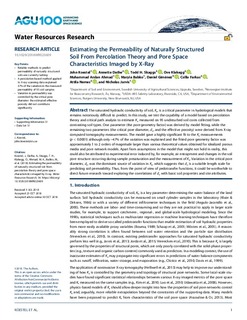| dc.contributor.author | Koestel, John | |
| dc.contributor.author | Dathe, Annette | |
| dc.contributor.author | Skaggs, Todd H. | |
| dc.contributor.author | Klakegg, Ove Mindor | |
| dc.contributor.author | Ahmad, Muhammad Arslan | |
| dc.contributor.author | Babko, Maryia | |
| dc.contributor.author | Giménez, Daniel | |
| dc.contributor.author | Farkas, Csilla | |
| dc.contributor.author | Nemes, Attila | |
| dc.contributor.author | Jarvis, Nicholas | |
| dc.date.accessioned | 2018-12-07T09:38:11Z | |
| dc.date.available | 2018-12-07T09:38:11Z | |
| dc.date.created | 2018-11-23T14:38:02Z | |
| dc.date.issued | 2018-10-30 | |
| dc.identifier.citation | Water Resources Research. 2018, . | nb_NO |
| dc.identifier.issn | 0043-1397 | |
| dc.identifier.uri | http://hdl.handle.net/11250/2576554 | |
| dc.description.abstract | The saturated hydraulic conductivity of soil, Ks, is a critical parameter in hydrological models that remains notoriously difficult to predict. In this study, we test the capability of a model based on percolation theory and critical path analysis to estimate Ks measured on 95 undisturbed soil cores collected from contrasting soil types. One parameter (the pore geometry factor) was derived by model fitting, while the remaining two parameters (the critical pore diameter, dc, and the effective porosity) were derived from X‐ray computed tomography measurements. The model gave a highly significant fit to the Ks measurements (p < 0.0001) although only ~47% of the variation was explained and the fitted pore geometry factor was approximately 1 to 2 orders of magnitude larger than various theoretical values obtained for idealized porous media and pore network models. Apart from assumptions in the model that might not hold in reality, this could also be attributed to experimental error induced by, for example, air entrapment and changes in the soil pore structure occurring during sample presaturation and the measurement of Ks. Variation in the critical pore diameter, dc, was the dominant source of variation in Ks, which suggests that dc is a suitable length scale for predicting soil permeability. Thus, from the point of view of pedotransfer functions, it could be worthwhile to direct future research toward exploring the correlations of dc with basic soil properties and site attributes. | nb_NO |
| dc.language.iso | eng | nb_NO |
| dc.rights | Navngivelse 4.0 Internasjonal | * |
| dc.rights.uri | http://creativecommons.org/licenses/by/4.0/deed.no | * |
| dc.subject | Permeability | nb_NO |
| dc.subject | Saturated hydraulic conductivity | nb_NO |
| dc.subject | Soil | nb_NO |
| dc.subject | Critical path analysis | nb_NO |
| dc.subject | Percolation | nb_NO |
| dc.subject | Model | nb_NO |
| dc.title | Estimating the Permeability of Naturally Structured Soil From Percolation Theory and Pore Space Characteristics Imaged by X-Ray | nb_NO |
| dc.type | Journal article | nb_NO |
| dc.type | Peer reviewed | nb_NO |
| dc.description.version | publishedVersion | nb_NO |
| dc.rights.holder | ©2018. The Authors. | nb_NO |
| dc.subject.nsi | VDP::Landbruks- og Fiskerifag: 900::Landbruksfag: 910::Naturressursforvaltning: 914 | nb_NO |
| dc.source.pagenumber | 9 | nb_NO |
| dc.source.journal | Water Resources Research | nb_NO |
| dc.identifier.doi | 10.1029/2018WR023609 | |
| dc.identifier.cristin | 1634344 | |
| dc.relation.project | Norges forskningsråd: 240663 | nb_NO |
| cristin.ispublished | true | |
| cristin.fulltext | original | |
| cristin.qualitycode | 1 | |

